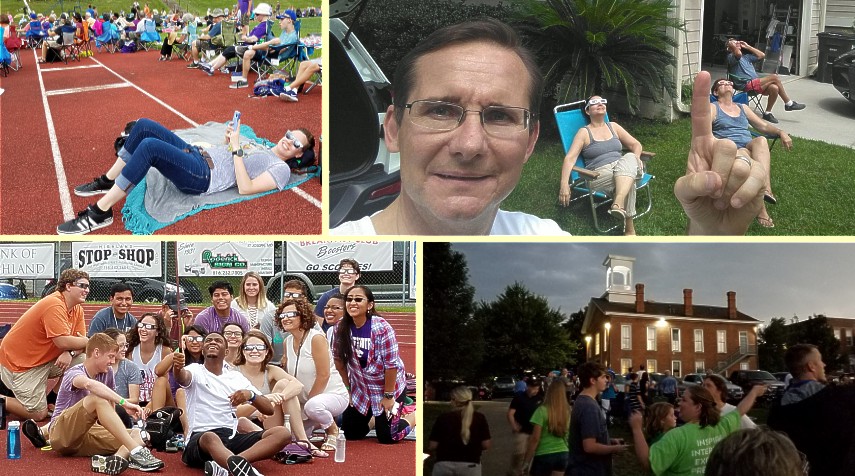Kansas Snapshots by Gloria Freeland - September 8, 2017
Totally worth the effort
The weather forecast for the day wasn’t promising. Local meteorologists predicted clouds with some rain. I hoped they were
wrong.
They weren’t. I awoke Aug. 21 to a cloudy and humid day. I sighed. I had been looking forward to the Kansas State
University-sponsored total-solar-eclipse trip for weeks. But I decided I wasn’t going to let a few clouds dampen my
spirits.
At 7:45 a.m., daughter Mariya and I met at the K-State Union where we were given special solar eclipse eyewear. Then we
boarded a bus, part of a two-hour caravan carrying more than 500 K-Staters and others from the Manhattan, Kansas area. We
went east on I-70 and then north on Highway 75. As had been predicted, the going was slow because of the thousands of others
all hoping to see the astronomical phenomenon. Rain pelted the bus on part of the journey.
“Oh, boy, not looking good,” I said to Mariya, shaking my head.
I was glad I had brought my rain coat. But the trip would have been better if we had not been seated next to the toilet.
Some overly-sweet sanitizer had been used, making me feel as if we were in a perfume factory.
A student in K-State’s astronomy club answered some questions during the journey. Mariya listened to music and, at one
point, had me listen to “Total Eclipse of the Heart” by Bonnie Tyler. Later, I read that Tyler performed the song on a
Caribbean cruise ship during the eclipse and that sales of her 1983 hit went up 500 percent in the week preceding.
We arrived in Highland, Kansas, population 1,000, about 10:30 a.m. It was one of the towns in the path of totality that cut
across 14 states from Oregon to South Carolina. We filed into the field house of the local community college and could feel
the sense of excitement.
Chris Sorensen, K-State distinguished professor of physics, spoke at 11 a.m. He told us solar
eclipses occur at least twice a year, but it’s rare for the path of totality to be in the U.S., much less cut across so
much of the country.
To illustrate the sizes of the earth, moon and sun in relation to each other, he asked one woman to hold up a baseball to
represent the earth and another to hold up a marble to represent the moon.
“And then you have this truck - the sun - over here,” he said.
He told us the moon rotates around the earth and the earth rotates on its axis and an eclipse occurs when the moon comes
between the earth and sun, making a shadow.
Then we went outside and made ourselves comfortable on the spongy track surface. Mariya and I had each brought blankets.
I had packed a lunch, so we spread out and relaxed with hundreds of others. One K-State group took several selfies, a couple
of women knitted, some people read or checked Facebook, and others played cards.
It was mostly cloudy, but about 20 minutes before noon, the clouds parted and we saw “first contact” - the
moment when the moon just begins to block the sun. Lots of “oohs” and “ahs” and “yays” and applause followed. To
me, it looked liked Pacman from the old arcade game taking a bite out of the moon.
“Oh, it’s teasing us,” someone nearby said, as the clouds came and went. “Now we see it; now we don’t.”
One minute it was unbearably hot and sticky and the next, a breeze came along to cool us off. Then a few sprinkles came.
And then at about 20 minutes past noon, the sprinkles became larger rain drops.
Most of us returned to the field house with our belongings, feeling a bit dejected. But 25 minutes later, the rain quit,
and we trekked back outside. The clouds parted again and once more we donned our solar glasses. The moon had obscured most of
the sun so the part we saw appeared as a deep golden crescent.
More “oohs” and “ahs” and “yays” and applause.
“I’m going to have to go to my chiropractor to have a neck adjustment,” one woman said as she craned her neck to see.
Although the clouds returned during the predicted 1:05 p.m. “totality,” we were still able to experience our part of the
world turning dark. Lights on campus buildings and around the track came on. It seemed much like night. We all twirled
around 360 degrees so we could see what it looked like around us.
Mariya pointed to a bright object in the sky. “Look over there, Momma!” We weren’t sure if it was a star or a planet, but it was as
vivid as if we were watching at dusk.
A friend in Charleston, South Carolina later told me he was surprised at how fast it went dark and the temperature
went down.
Husband Art, doing some work on our cottage in Wisconsin, considered the whole thing a non-event. It was only a partial eclipse
there and so he hadn’t even checked the time when it would happen. He was outside painting when he noticed the light fading
in a cloudless sky. At first puzzled, he laughed when he looked at his watch. Although unplanned, he too had seen the
eclipse.
For me, the effect was a bit more profound. I felt a chill - and it wasn’t from the weather. I had just experienced a total solar
eclipse for the first time. No, conditions weren’t optimal, but there were still enough “ooh” and “ah” moments to make it
totally worth the effort.
